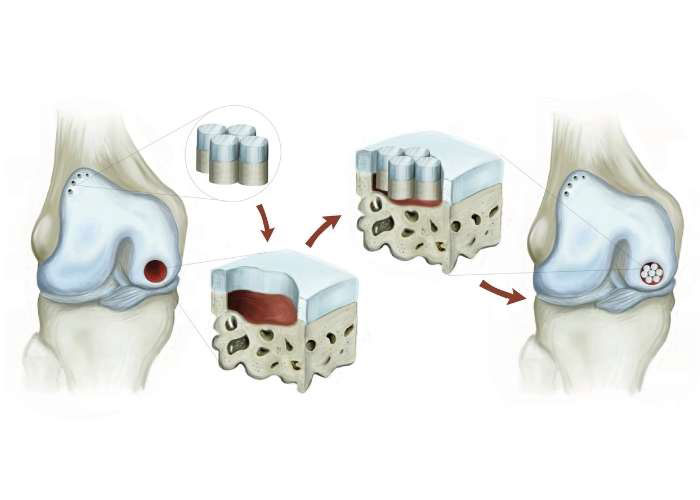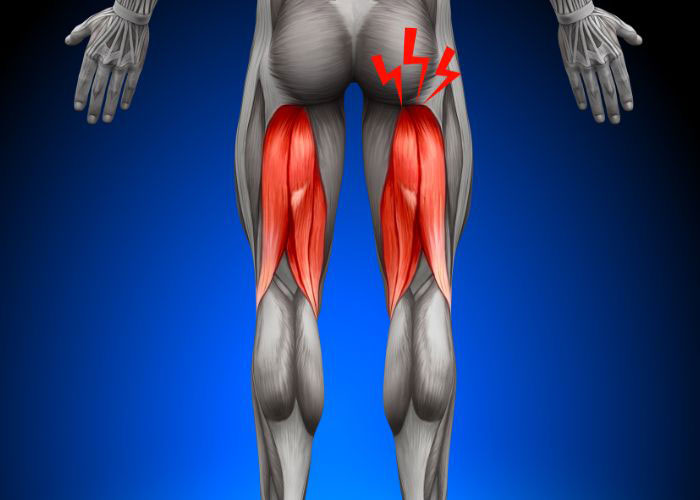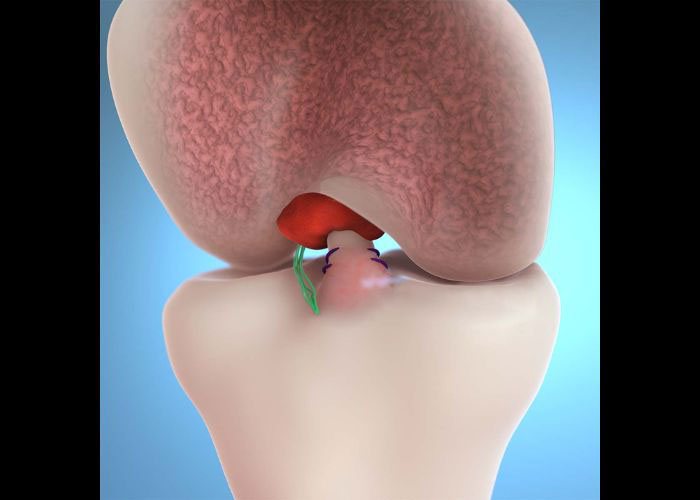What is an articular cartilage injury?
The lower end of the femur (thigh bone) and the upper end of the tibia (shin bone) join together to form the knee joint. Surrounding the ends of these bones is a slippery white connective tissue known as articular cartilage. The primary role of this articular cartilage is to reduce friction with joint movement, but it also provides a layer of protection to the bones. The normal “wear-and-tear” of the knee joint or a traumatic injury can injure the articular cartilage. If cartilage damage is not properly addressed, the painful condition of bone-on-bone movement known as osteoarthritis can develop over time.
What is the treatment for an articular cartilage injury?
Conservative treatment measures, such as rest, ice, and non-steroidal anti-inflammatory medications (NSAIDs), may be beneficial for patients with small articular cartilage defects. Surgical intervention may be necessary if conservative therapy was unsuccessful or if significant articular cartilage damage was sustained. However, patients with a singular cartilage injury or lesion are more likely to benefit from surgical intervention than patients with multiple cartilage defects. There are two surgical techniques that can be conducted for articular cartilage transplantation. Dr. Ronak Mukesh Patel, orthopedic knee doctor, treats patients in Sugar Land, Pearland, and the Houston, Texas area, who have experienced an articular cartilage knee injury and are in need of articular cartilage transplantation.
How is articular cartilage transplantation performed?
It is important to note that surgical intervention should only be performed by an experienced orthopedic knee surgeon due to the individualization of each surgical procedure. A surgical procedure for articular cartilage transplantation is often preceded by a chondroplasty to remove the damaged cartilage fragments. Below are the two surgical techniques that can be implemented for articular cartilage transplantation:
- Osteochondral Autograft/Allograft Transplantation Surgery (OATS): A cartilage graft, either from the patient (autograft) or a donor (allograft), is utilized as a surface for new cartilage to grow. This new tissue is molded to the patient’s specific cartilage defects to provide the best recovery outcome.
- Particulated Juvenile Cartilage Allograft Transplantation (PJCAT): This technique implements articular cartilage derived from young donors and is used to fill the defect.
What is the recovery period like after articular cartilage transplantation?
The recovery period following articular cartilage transplantation is determined by the specific surgical technique conducted by Dr. Patel. Patients can expect a full recovery from the OATS procedure in approximately 4 to 6 months, while a full recovery from PJCAT can be expected in approximately 6 months. The following can be anticipated by patients in the Houston, Texas area:
- As a protective measure for the new cartilage, the knee joint will be placed in a brace immediately after surgery.
- A continuous passive motion (CPM) machine may be used for up to 6 weeks after surgery.
- Weight-bearing will be limited with the assistance of crutches or a walker.
- Management of post-operative pain and inflammation is achieved through a combination of rest, ice, and non-steroidal anti-inflammatory medications (NSAIDs).
- Active participation and completion of this physical rehabilitation program as prescribed by Dr. Patel is the key to a successful recovery following articular cartilage transplantation.
Articular Cartilage Transplantation Surgeon

The articular cartilage in the knee can become damaged or injured from from a traumatic event or from normal wear and tear. Damaged tissue left untreated can cause osteoarthritis. Articular cartilage restoration surgeon Doctor Ronak Mukesh Patel, provides diagnosis as well as surgical and nonsurgical treatment options for patients in Houston, Sugar Land, and Pearland, TX who have damaged the articular cartilage in their knee. Contact Dr. Patel’s team today!









